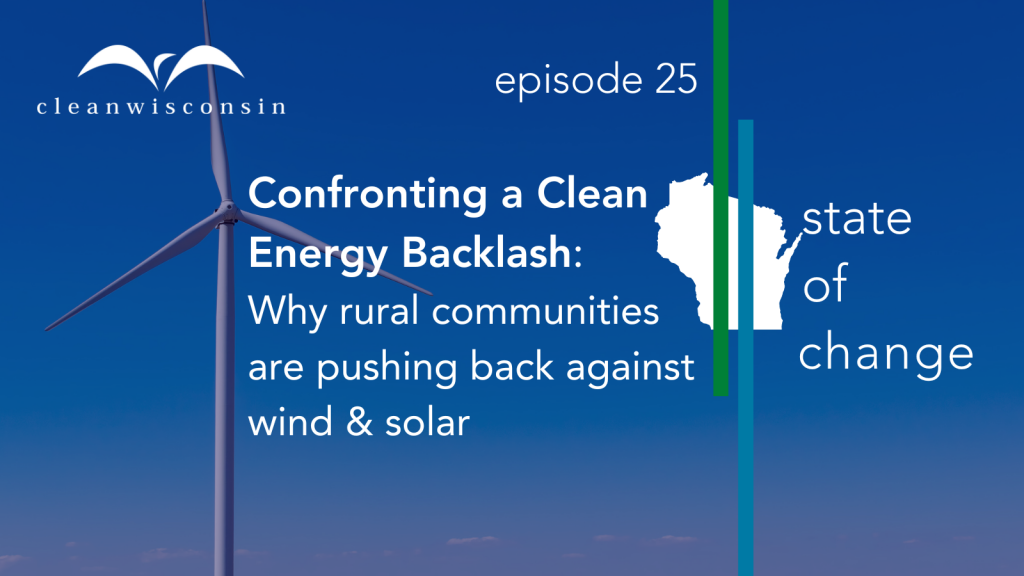Some rural communities in Wisconsin are pushing back against wind & solar, but it doesn’t have to be that way. Find out how you can help stop a clean energy backlash.
To reach our climate goals, Wisconsin needs to build one major wind project and three to four large solar farms every year for the next few decades. But a wave of pushback could be coming. Some Wisconsin communities are working to pass ordinances making it harder to build those clean energy projects. It’s something happening across our region.
In this episode we talk with Dr. Sarah Mills from the University of Michigan who’s been working in rural communities as they respond to the clean energy projects that are cropping up in their backyards.
Host: Amy Barrilleaux
Guest:
Background Reading:
Wisconsin’s Roadmap to Net Zero by 2050
Analysis reveals solar farms produce 100 times more energy than ethanol
Modeling shows Koshkonong solar farm will improve the health for nearby waterways
Where to Listen:
Full Transcript:
Amy Barrilleaux: New large scale wind and solar projects are in the works across Wisconsin and the Midwest. And for many of us worried about climate change, that’s good news. But it’s not good news to everybody. Some Wisconsin communities are working to pass ordinances making it harder to build those clean energy projects. It’s something happening across the region. In this episode, I’ll talk with a researcher who’s been working in rural communities in the Midwest as they respond to the clean energy projects that are coming to their backyards. I’m Amy Barrilleaux, and this is State of Change from Clean Wisconsin.
To reach our climate goals, Wisconsin needs to build one large wind project and three or four big solar farms every year, starting now. But a wave of pushback could be coming. Joining me is Dr. Sarah Mills from the University of Michigan, who’s been researching how rural communities are responding to big wind and solar projects. As I said, some communities are starting to look at ordinances and restrictions that are aimed at stopping these projects. Are you surprised that’s starting to happen?
Sarah Mills: Not so much because I feel like many of them are not coming to renewables themselves. Usually it’s something that’s suggested to them by someone else, by an outside entity. And they’re having to respond to a project proposal rather than–and maybe the experience in Wisconsin is a little bit different than it is in Michigan. But in Michigan, we often see local governments block this when they’re faced with a proposal. So I think that it’s not surprising. I think when communities think about renewables proactively and how it may they wind or solar may be able to get them the things that they want–diversified income for their farmers or a new revenue stream for the local government. Or again, not tons of jobs, but but construction jobs and, you know, some pretty well-paid jobs in terms of maintenance. And again, it’s just a handful of long term jobs in these, you know, for those particular things. But when they think about how those things could get them the things that they want, you don’t necessarily have community is saying no. Some people some communities, you know, would still say, “This is not the kind of economic development that we want. This changes our landscape.” I mean, you have I’m sure you have this in Wisconsin, right? And there’s there’s no doubt about it. Like 500, 600 foot tall wind turbines. You can see that on the landscape. Solar at the scale that we’re talking about, this is not a couple acres. We’re talking hundreds of acres, thousands of acres in some cases. That’s a change to the landscape. And so some some communities, and my research finds that there’s kind of a pattern as to which communities say, “It’s not worth it. The economic benefits that come with it are just not worth that change to the landscape.” But I think when you’re reacting to something, the knee jerk reaction is easy to say no. But when you’re thinking about it in terms of what it is that your community wants, and whether it’s a tool to get you what you want, I think you have a much more measured response.
Amy Barrilleaux: At Clean Wisconsin, we are environmental advocates, so we often talk about the climate impact of wind and solar. You know, transitioning to clean energy is something that has to happen and it has to happen fast. It feels like that should be hugely motivating for people. But does that really work to get people on board with these large scale projects?
Sarah Mills: I don’t want to tell you how to do your business, but let me start by saying I am on the Planning Commission at the City of Ann Arbor, which has declared a climate emergency and wants to be carbon neutral citywide by 2030. We are a place where a lot of people–there’s a long commitment to climate action. And even still, the kind of projects that we would need for climate action, which is building more housing in the city. We have people showing up, you know, saying, “We don’t want that.” If you don’t agree with what the climate solution is in your particular place, even if you believe in climate change, that’s not necessarily–I don’t see climate as the huge motivator, even in the place where there’s lots of people that understand the science. So I think that that’s an important element, I think. I mean, maybe…Wisconsinites?
Amy Barrilleaux: Wisconsinites, that’s right!
Sarah Mills: Wisconsinites! Yeah. Okay. I was gonna say, we’re Michiganders! Right, Right. Maybe Wisconsinites are different than Michiganders, but of all Michiganders that have wind turbines on their property, 60% of them don’t believe in climate change. They host wind turbines because this makes economic sense for their family farm. And I think that that that is really what’s been driving it. And in some ways kind of putting it in the context of climate, I’ve seen it backfire more than I’ve seen it kind of open new doors.
Amy Barrilleaux: What we’re seeing here in Wisconsin is farmers who are looking to diversify their land or maybe looking at the price of corn for ethanol versus the amount of income they can get to host solar. And they are opting to have these large scale projects on their land. But I think they’re not the ones necessarily who are pushing back. What are you finding over there in Michigan?
Sarah Mills: I’m finding… So solar and wind, I think, operate a little bit differently, in part just because the wind footprint can be large, but the actual amount of land that it takes up is pretty small. It is in many, many places, this is farmers and their non farming neighbors who have a difference of opinion. And honestly, I should admit that my background is in farmland preservation. It’s not an energy. I study energy as a farmland preservation tool. So this idea that there would be differences about what rural land is about between farmers and their non farming neighbors is pretty common for lots of different land uses. So I think we’re seeing that. And solar, I mean, I’ve also seen some farmers, clearly people who want it on their property, like, you know, nobody’s forcing them to. Finally, I think there is some consternation among some of their of their farming neighbors even about what does taking a couple hundred couple thousand acres out of production mean for the farming economy? And so I have some active research right now on trying to understand that. Like, yeah, the corn may be sold for ethanol, but it’s still keeping your, you know, potentially keeping the implement dealer in business. Right? And you’re keeping the grain elevator, you know, you’re processing grain through there. So if we take some land out of production for corn and soybeans, and replace it with solar, we know there might be some impact on the farming economy. But is it offset by the additional taxes that are paid, or the additional community wide revenues that are paid by solar, or the things that the people who host solar on their property do with that money? My research has found that people with wind turbines on their property reinvest it in their farm. For solar, we’re trying to understand does that happen? And we have some stories of that happening. Or are people using this as their retirement, which is totally cool. It’s just if you’re retiring to Florida or Arizona and taking your money with you, that plays differently in terms of the local economy. So all of those are things that I’m trying to get answers to right now.
Amy Barrilleaux: We’re also seeing not just in Wisconsin, but pretty much everywhere, a lot of misinformation and distorted information about wind and solar, everything from health impacts of low level wind turbine noise to rumors about solar panels leaking chemicals. And the reaction from clean energy experts is often to put out studies and facts that have the correct information. It seems like that’s how to respond, but it doesn’t feel like that’s working. Why doesn’t it work?
Sarah Mills: Because it I think it depends on who’s delivering the facts and whether people are open to hearing the facts. Right. And so just jinformation alone doesn’t change people’s minds. And people look for confirmation bias, too. So when there’s competing facts and local officials, I see this in Michigan and I’m imagining this is happening in Wisconsin, local officials are, you know, have people who want renewables and those who don’t want renewables showing up with competing facts. And they’re trying to balance, like which one is actually true. But also other people in the community who may not know, maybe haven’t seen those–you can’t see my air quotes–“facts” before. You know people are more likely to hear the thing that is in keeping with what they thought. Right? And I think really importantly coming from somebody that they trust. So if the person pushing the information is not somebody who’s speaking your language or you who you think is trustworthy, I think it doesn’t make a difference if it’s true. So that’s where I think fighting it is really hard.
Amy Barrilleaux: Yeah, I think climate advocates would say all this misinformation and cherry picking of facts, all the confusion is slowing things down when we really need to be moving fast. But beyond that, I think there’s just general opposition to the kind of change that we’re talking about. I mean, it’s easy for me sitting here in Madison, Wisconsin, to say, “Yep, we can do this. We can build, you know, one large wind project and three or four big solar farms every year.” But what does it feel like, though, for somebody–I know you can’t speak for every person in the rural upper Midwest, but how hard of a change is this? How different will our landscape be if we can build these large projects at the pace that we need?
Sarah Mills: So every energy source has local impacts. I think one of the things that’s really tricky about the the transition that we’re facing is just because of the footprint of renewables. It’s not possible to close old power plants and put renewables on that same footprint. So it requires communities that have historically imported energy, right, to be exporters of energy. Because for most of the places, for most of these rural communities, at least the ones that I work in, and I’m sure this is true in Wisconsin, you know, a single wind turbine, maybe two wind turbines or 20 acres of solar is effectively what they need to to generate and be self-sufficient. But that’s not how our energy system works. It’s connected. And so when rural communities are being asked to host 50 wind turbines or a couple thousand acres of solar panels, even if all you’re really talking about is are aesthetic changes, even if there are you know, there are there are some additional kind of changes that come along with it, too. I mean, I think that that we that city dwellers ought to be cognizant of that. And I think what’s particularly tricky in this space is when decisions are made that are, you know, at the local government level that are based on kind of democracy and that’s what that rural community wants. I have troubles with outsiders overruling that. If you think the problem is that the decisions are being made in rural communities based on false information or false pretenses, then that’s something that can be addressed. But just to just say, “We outsiders know better what’s okay for your community,” I feel tons of empathy for rural communities in that situation. [
Amy Barrilleaux: I think when, and correct me if I’m wrong, but I think when these projects happen, typically, you know, the company kind of goes off and meets with the landowners that they need and then signs all the contracts and then the public hears about it. Is that basically the typical process?
Sarah Mills: That’s the typical process, which I again, if I could push pause, right? I mean, when a community feels like this is something that they want themselves… We have some examples of this in Michigan. This the center of the state where it’s not the windiest place, but the community determined that wind energy was their way to diversify farm income and keep their farmers in business long term. So they did the planning. They organized their neighboring local governments to effectively write a zoning ordinance so the local rules to make it really easy for a wind developer to do business there. They effectively attracted wind developers. And this is a place that, again, is not that windy, but has now become Michigan’s wind capital and has built more and more projects because, I think, this is something that they did on their terms. And I think that there’s a lot of power in that. And I mean, one of the biggest tricks and I’m not going to lie about this I’m a planner, is how do you get people to plan? How do you get people to be proactive rather than just to be reactionary? Because it takes effort and it takes money to start that conversation when you don’t know that it’s necessarily going to lead to a project.
Amy Barrilleaux: We’re having this conversation because we are in this time of change, urgent, necessary change because we’re facing a climate crisis. Do you really see this being successful, this energy transition that has to happen? Do you think we’re going to get there and get there fast enough, at least here in our backyard in the upper Midwest?
Sarah Mills: That’s a really great question. I am a perpetual optimist in this space, because again, I will say that I came at energy from farmland preservation, and I do believe that renewable energy provides an economic opportunity for farming communities that these communities haven’t seen in decades. And so I think that the stories of where this has been true and the policy that not, you know, the policy environment that has led that to be true hasn’t been advertised enough. And I, I do think that when communities understand, kind of true farming communities understand this, I think that there will be a more of an embrace of renewables. My fear is that instead we are changing things to say, “Communities are going to take it like whether you like it or not.” And that is not, I don’t think that’s going to work out well in our neck of the woods. And I honestly I mean, maybe in the short I mean, sure, in the short term it could, but I don’t know in the long term that that works out well for any of us. And particularly if we want to build bridges, you know, and not lead to further divide between urban and rural places. I mean, to be clear that the kind of consternation in a rural community is between rural folks together. Right? Like it’s it’s the farmers and non farming neighbors that may have a difference of opinion of a particular land use. But but kind of how policy reacts needs to be cognizant of this is in terms of the energy infrastructure itself. We’re really talking about what the land use policy is in rural communities, and I think it’s really important that we center the voices of rural communities in those decisions. Again, I think it’s a huge opportunity. I’m an optimist, but I, I think in the short term, building that trust and getting there is–you might have to go slow in order to go fast or in order to go big.
Amy Barrilleaux: So we are a membership based organization. We have members all across the state. If somebody is listening to this and they’re in a rural community and maybe, you know, there’s a project of some kind that’s being proposed near them, what can they do to start this conversation in a way that might be seen as positive or lead to a positive place?
Sarah Mills: I think particularly if you’re a rural in in a rural community, show up. I mean, I’m on a planning commission in a city, right? I know that people show up to speak against things rather than to speak for things. So show up and speak the language that you know, to speak. I mean, regularly I have to, you know, talk to my urban students about how you talk to folks in rural communities. Right? But if you’re already in a rural environment, you have that ability because you know what it what it’s like–kind of the struggles that you’re facing and kind of the arguments that that fit with your area. I would also say, even if there’s not a proposal in place. I think this is, I mean, again, I’m a planner. Show up and say, “Let’s have a conversation about whether it’s an option. This is an opportunity for us.” Because particularly when we’re talking about solar, there’s not huge differences in solar potential from place to place. There are differences in access to the transmission points. I get that. But it’s not as place-specific as it is with wind. And so there’s a real opportunity if your community wants this to attract it to your place by making it really easy and saying, “Hey, sign us up.” And so I would encourage you to to start those conversations and have the conversation about renewables on your terms and your community’s terms. So even if you’re even if you’re in a rural environment and there hasn’t yet been a renewable proposal. What I told rural communities in Michigan is within the next year, ten years, somebody’s going to be knocking on your door. And I can’t imagine that that’s different in Wisconsin. So start the conversation now.
Amy Barrilleaux: Dr. Sarah Mills from the University of Michigan, thank you so much for joining me and for sharing your insight. I really appreciate it. [00:19:34][5.9]
Sarah Mills: Great. Thanks for having me. [00:19:36][0.8]
Amy Barrilleaux: To find out more about clean energy and wind and solar projects happening in Wisconsin, log on to our website, Clean Wisconsin, dawg. I’m Amy Berio and you’ve been listening to State of Change from Clean Wisconsin.






